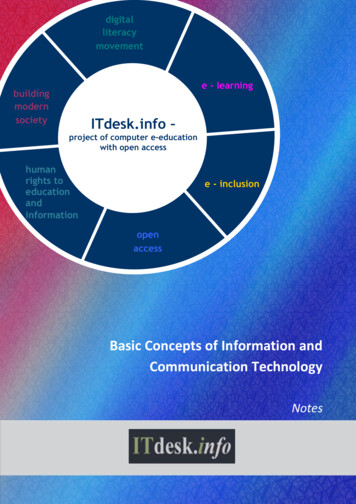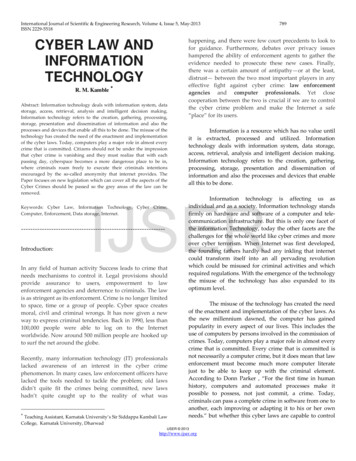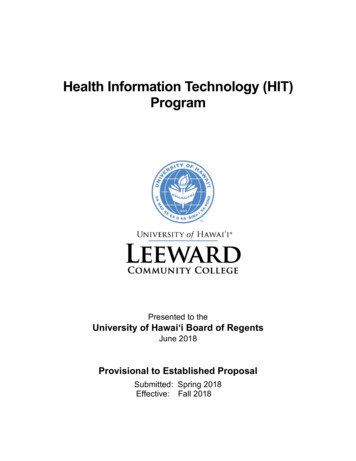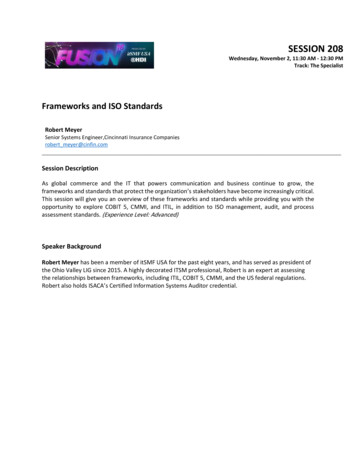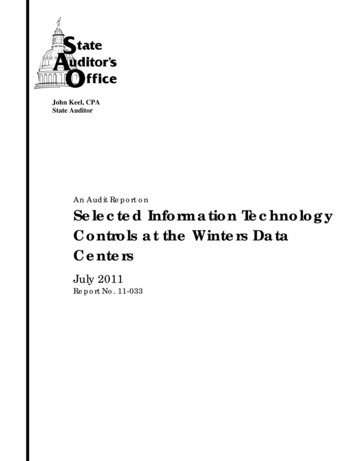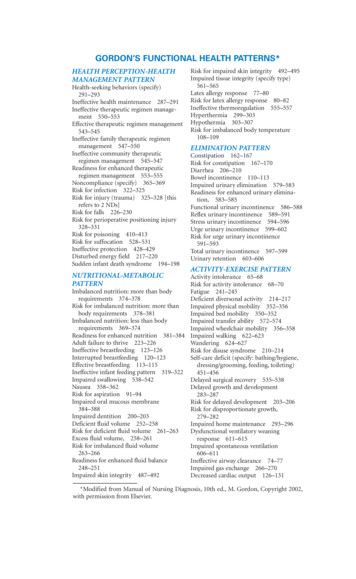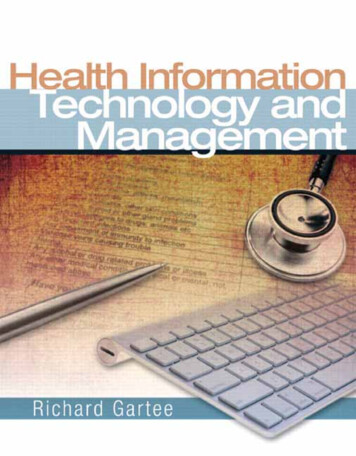
Transcription
ISBN 1-256-40031-9Health InformationTechnology and ManagementHealth Information Technology and Management, First Edition, by Richard Gartee. Published by Prentice Hall. Copyright 2011 by Pearson Education, Inc.
ISBN 1-256-40031-9Health Information Technology and Management, First Edition, by Richard Gartee. Published by Prentice Hall. Copyright 2011 by Pearson Education, Inc.
ISBN 1-256-40031-9PearsonBoston Columbus Indianapolis New York San Francisco Upper Saddle RiverAmsterdam Cape Town Dubai London Madrid Milan Munich ParisMontreal Toronto Delhi Mexico City São Paulo SydneyHong Kong Seoul Singapore Taipei TokyoHealth Information Technology and Management, First Edition, by Richard Gartee. Published by Prentice Hall. Copyright 2011 by Pearson Education, Inc.
Library of Congress Cataloging-in-Publication Data.Gartee, Richard.Health information technology and management/Richard Gartee.p. cm.Includes bibliographical references and index.ISBN-13: 978-0-13-159267-4 (alk. paper)ISBN-10:0-13-159267-X (alk. paper)1. Medical records—Data processing. I. Title.[DNLM: 1. Medical Records Systems, Computerized. 2. Forms and Records Control—methods.WX 173 G244h 2011]R864.G374 2011610'.285—dc222009035087Publisher: Julie Levin AlexanderPublisher's Assistant: Regina BrunoEditor-in-Chief: Mark CohenExecutive Editor: Joan GillAssociate Editor: Bronwen GlowackiDevelopmental Editor: Jill Rembetski, Triple SSS PressMedia Development.Editorial Assistant: Mary Ellen RuitenbergDirector of Marketing: Karen AllmanSenior Marketing Manager: Harper ColesMarketing Specialist: Michael SirinidesMarketing Assistant: Judy NohManaging Production Editor: Patrick WalshProduction Liaison: Julie BoddorfProduction Editor: Peggy KellarSenior Media Editor: Amy PeltierMedia Project Manager: Lorena CerisanoManufacturing Manager: Ilene SanfordManufacturing Buyer: Pat BrownSenior Art Director: Maria GuglielmoArt Director: Kristine CarneyInterior Designer: Nesbitt Graphics, Inc.Cover Designer: Koala Bear DesignCover Images: Istockphoto.com and ShutterstockDirector, Image Resource Center: Melinda ReoManager, Rights and Permissions: Zina ArabiaManager, Visual Research: Beth BrenzelManager, Cover Visual Researchand Permissions: Karen SanatarImage Permission Coordinator: Debbie LatronicaComposition: Aptara , Inc.Printing and Binding: QuebecorCover Printer: Phoenix Color CorporationCopyright 2011 Pearson Education, Inc., publishing as Pearson, One Lake Street, Upper Saddle River,New Jersey 07458. All rights reserved. Manufactured in the United States of America. This publication is protected byCopyright, and permission should be obtained from the publisher prior to any prohibited reproduction, storage in aretrieval system, or transmission in any form or by any means, electronic, mechanical, photocopying, recording, orlikewise. To obtain permission(s) to use material from this work, please submit a written request to Pearson Education,Inc., Permissions Department, Prentice Hall, One Lake Street, Upper Saddle River, New Jersey 07458.ISBN 13: 978-0-13-159267-4ISBN 10:0-13-159267-XHealth Information Technology and Management, First Edition, by Richard Gartee. Published by Prentice Hall. Copyright 2011 by Pearson Education, Inc.ISBN 1-256-40031-910 9 8 7 6 5 4 3 2 1
ISBN 1-256-40031-9for DadHealth Information Technology and Management, First Edition, by Richard Gartee. Published by Prentice Hall. Copyright 2011 by Pearson Education, Inc.
Brief ContentsChapter 1Healthcare Delivery Fundamentals 1Chapter 2 Health Information Professionals22Chapter 3 Accreditation, Regulation, and HIPAA42Chapter 4 Fundamentals of Information Systems74Chapter 5 Healthcare Records98Chapter 6 Organization, Storage, and Managementof Health Records 127Chapter 7 Electronic Health Records 152Chapter 8 Additional Health Information Systems182Chapter 9 Healthcare Coding and Reimbursement 207Chapter 10 Healthcare Transactions and Billing237Chapter 11 Health Statistics, Research, and QualityImprovement 260Chapter 12 Management and Decision Support Systems283Glossary 303Index 319ISBN 1-256-40031-9VIHealth Information Technology and Management, First Edition, by Richard Gartee. Published by Prentice Hall. Copyright 2011 by Pearson Education, Inc.
ContentsPrefacexivIntroduction xivAHIM Competencies xivThe Development and Organization of the Text xviLearning Made Easy xixAbout the Author xxiiiAcknowledgments21Chapter 2 Health InformationProfessionals 22xxivChapter 1 Healthcare DeliveryFundamentals 1Understanding Healthcare Facilities 2Ambulatory Care Facilities 2Diagnostic and Therapy Facilities 2Acute Care Facilities 3Declining Numbers of Acute Care Hospitals 5Emergency Department 6Subacute Care Facilities 6Rehabilitation Facilities 6Long-Term Care Facilities 6Home Care 6Comparing Inpatient and OutpatientFacilities 7Differences That Affect Health InformationManagement 8Admission and Discharge 9Healthcare Providers and Professions 11Direct Care Providers 11Doctors 11Nurses 14Physician Assistants 14A Real-Life Story: A Nurse Practitioner Talks aboutHer Profession 15Allied Healthcare Professions 16Clinical Allied Health Professionals 16Nonclinical Allied Health Professionals 18Organizations of Importance to ClinicalProfessionals 18ISBN 1-256-40031-9Critical Thinking Exercises 21Testing Your Knowledge of Chapter 1American Medical Association 18American Nurses Association 18American Hospital Association 19Chapter 1 Summary19History of Health Information Managementand Organizations 23From Record Systems to Information SystemsHIM, HIT, and HIS 25Increased Computerization 2724Health Information Professionals 27A Real-Life Story: Building an all Digital Hospital 28HIM Department Professionals 29Health Information Director or Manager 29Registered Health Information Administrator 29Registered Health Information Technician 29Clinical Data Specialist 29Clinical Coding Specialist 29Coding Associate 29DRG Coordinator 31APC Coordinator 31Medical Transcriptionist 31Cancer Registrar 31HIM Compliance Specialist 31Optical Imaging Coordinator 31IT Department Professionals 31Information Services or Information TechnologyDirector or Manager 32Clinical Project Manager and IT Project Manager 32Clinical Analyst 33Clinical Vocabulary Manager 33Clinical Applications Coordinator 33Data Quality Manager 33Data Resource Administrator 33Decision Support Analyst 33Health Information Services Department Technician 33Enterprise Applications Specialist 34Integration Architect 34Health Systems Specialist 34Solution Analyst 34Solution Consultant 34Systems Analyst 34Information Security Manager 34Records and Information Coordinator 34VIIHealth Information Technology and Management, First Edition, by Richard Gartee. Published by Prentice Hall. Copyright 2011 by Pearson Education, Inc.
VIIICONTENTSOfficers and Other Positions 34Privacy Officer 34A Real-Life Story: Examples of Project Management 35Information Privacy Coordinator 35Security Officer 35Compliance Officer 35Utilization Manager 36Quality Improvement Director 36Senior Document Coordinator 36Risk Management Specialist 36Health Services Manager 36Patient Information Coordinator 36Clinical Research Associate 36Medical Office Manager 36Medical Assistant 36Health Insurance Specialist 36Organizations of Importance to HIM or ITProfessionals 37American Health Information Management Association 37Healthcare Information and ManagementSystems Society 37American Medical Informatics Association 37Medical Group Management Association 38American College of Medical Practice Executives 38American National Standards Institute 38Health Level Seven 38Association for Healthcare Documentation Integrity 38National Cancer Registrars Association 38American Academy of Professional Coders 38National Association for Healthcare Quality 39Skills for Success 39Chapter 2 Summary 40Critical Thinking Exercises 41Testing Your Knowledge of Chapter 241Chapter 3 Accreditation,Regulation, and HIPAA 42Accreditation and Regulation43Centers for Medicare and Medicaid Services 43Federal, State, and Local Laws 44The Joint Commission 45College of American Pathologists 46Commission on Accreditation of RehabilitationFacilities 4747HIPAA’s Administrative Simplification Subsection 47HIPAA Transactions and Code Sets 48Eight HIPAA Transactions 48HIPAA Uniform Identifiers 4849HIPAA Privacy Rule 49Privacy Policy 50Consent 51Authorization 52Minimum Necessary 54Incidental Disclosures 54A Patient’s Right to Know about Disclosures 55Patient Access to Medical Records 55Health Information ManagementResponsibilities 55Personal Representatives 55Minor Children 56Business Associates 56A Real-Life Story: The First HIPAAPrivacy Case 57Civil and Criminal Penalties 58HIPAA Security Rule 58The Privacy Rule and Security Rule Compared 58Security Standards 59Implementation Specifications 59Administrative Safeguards 60Security Management Process 61Assigned Security Responsibility 62Workforce Security 62Information Access Management 63Security Awareness and Training 63Security Incident Procedures 64Contingency Plan 64A Real-Life Story: Contingency Plans Ensure ContinuedAbility to Deliver Care 65Evaluation 65Business Associate Contracts and OtherArrangements 65Physical Safeguards 66Facility Access Controls 66Workstation Use 67Workstation Security 67Device and Media Controls 67Technical Safeguards 67Access Control 67Audit Controls 69Integrity 69Person or Entity Authentication 69Transmission Security 69Organizational, Policies and Procedures, andDocumentation Requirements 70Organizational Requirements 70Policies and Procedures 70Documentation 70Chapter 3 Summary 70Critical Thinking Exercises 72Testing Your Knowledge of Chapter 373Health Information Technology and Management, First Edition, by Richard Gartee. Published by Prentice Hall. Copyright 2011 by Pearson Education, Inc.ISBN 1-256-40031-9HIPAAPrivacy and Security of Patient Records
CONTENTSTesting Your Knowledge of Chapter 4Chapter 4 Fundamentalsof Information Systems 74The Technology behind Health SystemsHardware 75CPU 75Memory and Storage 75Input and Output Devices 76Ergonomics 77Software 77Operating Systems 78Application Software 78Bits and Bytes—How Computers “Think”Extending Functionality 79Databases 80Networks 85Network Hardware 85Clients and Servers 85Local-Area Networks 86Wide-Area Networks 86Internet 87Protocols 87Secure Remote Access 88Wireless Networks 88Printers and Reports 89Report ServerCOLD 9089Interoperability Standards 90Data Elements 90Data Sets 90HL7 91Maintaining Interoperability 91CCOW 91ISBN 1-256-40031-9Communication Systems 92A Real-Life Story: A Look Behind theHospital Network 92E-Mail Systems 93Telecommunications 93Chapter 4 Summary 93Critical Thinking Exercises9495Comprehensive Evaluationof Chapters 1–4 9675Chapter 5 Healthcare Records 98Understanding Healthcare Records 99Functions of Healthcare Records 99Primary and Secondary Records 10179Types of Primary Health Records 101Types of Secondary Health Records 101Transition from Paper to ElectronicRecords 102Contents of Health RecordsCharacters 80Fields 80Records 81Files and Tables 81Data Dictionary 81Relational Data 83Images 84Image Storage: File or BLOB 84IX102Administrative and Demographic Data 102Consent and Directives 103HIPAA Consent to Use and DisclosePHI 103Consent to Treatment 103Medicare Patient Rights Statement 103Assignment of Benefits 104Informed Consent 104Refusal of Treatment 104Advance Directives 104Organ Donor 104Personal Property List 104Disclosure Records 104Clinical Documents 104Medical History 104Physical Exam 108Diagnostic and Therapeutic Orders 108Diagnostic and Therapeutic Reports 108Diagnostic Images 110Operative Records 110Nursing Notes 110Referral Consults 110Case Management 110Discharge Summary 110Obstetrical Records 113Pediatric Records 113Problem List 113Medication List 113Public Health Records 113Birth 113Death 113Disease 114Plan of Care 114Documentation StandardsData Elements 114Data Sets 114Policies and Procedures114117Health Information Technology and Management, First Edition, by Richard Gartee. Published by Prentice Hall. Copyright 2011 by Pearson Education, Inc.
XCONTENTSContinuity of Care Records118Regional Health Information Organization (RHIO) 118Who Owns the Record? 119The Personal Health Record 119Telemedicine119Teleradiology 120Patient Reporting and Telemonitors 121E-Visits 121Workflow of an E-Visit 121A Real-Life Story: Telemedicine at Mayo Clinics 122Chapter 5 Summary 124Critical Thinking Exercises 126Testing Your Knowledge of Chapter 5128Understanding the Scope of the ProblemHow Paper Charts Are Organized128128Source-Oriented Record 129Problem-Oriented Record 129Integrated Record 129Electronic Views 130Hybrid Health Records 130Loose Sheets 131133Record Circulation and Storage 135HIM Ethics 145Chapter 6 Summary 148Testing Your Knowledge of Chapter 6151Chapter 7 Electronic HealthRecords 152Evolution of Electronic Health Records153Institute of Medicine 153Computer-based Patient Record Institute 155HIPAA Security Rule 155EHR Defined 155Social Forces Driving EHR Adoption 155Health Safety 156Health Costs 156Government Response 156Changing Society 157157Form Affects Functionality 157Coded Data 157Standard EHR Coding Systems 158Functional Benefits from Codified RecordsHealth Maintenance 159Trend Analysis 161Alerts 162Decision Support 164Capturing and Recording EHR Data159165Documenting at the Point of Care 166Benefits of Real-Time Documentation 166Nurse and Medical Assistant-Entered Data 167Patient-Entered Data 167Workflow Using Patient-Entered Data 167Alternative Workflow 169Clinician-Entered Data 169Saving Clinicians’ Time 169Nomenclature 170Lists 171Forms 171Health Information Technology and Management, First Edition, by Richard Gartee. Published by Prentice Hall. Copyright 2011 by Pearson Education, Inc.ISBN 1-256-40031-9Problems with Paper Charts 136Duplicate Charts 136Chart Tracking Systems 137Storage for Paper Records 138Calculating Storage for Paper Records 138Critical Thinking Exercises 139Document Imaging Systems 139Record Retention 143Destruction of Health Records 144Release of Information 145Producing Legal Health Records 145Functional Benefits of an EHRFiling Paper Records 131Paper Chart Filing Systems 132Systems for Filing Numbered ChartsAlphanumeric Filing 133Straight Numeric Filing 133Color Coding 135How Charts Are Numbered 135Serial Numbering 135Unit Numbering 135Serial-Unit Numbering 135Family Numbering 135Legal and Ethical Management of HealthRecords 143126Chapter 6 Organization, Storage,and Management of HealthRecords 127Managing Health RecordsQuality Control 140Microfilm 141A Real-Life Story: Automating HIM Workflow 142
CONTENTSSearch 172Prompt 173Flow Sheets 174Orders 174Protocols 175Chapter 9 Healthcare Codingand Reimbursement 207Electronic Signatures 175Flow of an Office Fully Using EHRsHealthcare Business 208Patient Accounts and Registration176A Real-Life Story: Experiencing the Functional Benefitsof an EHR 178Chapter 7 Summary 179Critical Thinking Exercises 181Testing Your Knowledge of Chapter 7181Chapter 8 AdditionalHealth InformationSystems 182Departmental Information Systems 183Patient Registration 184Laboratory Services 186Stat Tests 188Digital Pathology189Radiology Department 189Digital X-Ray Images 190CAT/CT, MRI, and PET Images 191High-Resolution Monitors 191Dictation/Transcription SystemsPatient and Insurance Billing Terms 209Additional Insurance Billing Terms 210Codes for Billing211HIPAA Transaction Coding Standards 211CPT-4 211HCPCS 212Procedure Modifier Codes 212ABC 212ICD-9-CM 213DRG 215Future Developments: ICD-10 216ICD-10-PCS 216Billing Codes Differ from EHR NomenclaturesReimbursement Methodologies216217Fee for Service 217Allowed Amount 217Managed Care 218Capitation 218Preferred Provider Organizations 219Government-Funded Health Plans 219Medicare Part B Reimbursement 220Resource-Based Relative Value Scale 221Medicare Part A and MS-DRGs 223Relative Weight 224PPS Rate 225Hospitals Excluded from Inpatient PPS 226Determining the DRG 226Exceptions 227Outlier Cases 228Pharmacy Systems 195Emergency Department Systems 197Biomedical Systems 199Surgical Department Systems 199Other Medicare Prospective PaymentSystems 228Inpatient Psychiatric Hospital ProspectivePayment System 228Long-Term Care Hospital Prospective PaymentSystem 228Skilled Nursing Facility Prospective PaymentSystem 229Home Health Prospective Payment System 229Outpatient Prospective Payment System 229Operative Reports 199Implant Registry 200Transplant Registry 201Research and Clinical Trials 201Chapter 8 Summary 201Critical Thinking Exercises 204Testing Your Knowledge of Chapter 8Comprehensive Evaluationof Chapters 5–8 205208Prospective Payment System Reimbursement 223191Speech Recognition Software 193How Speech Recognition SoftwareWorks 193A Real-Life Story: Radiology in the DigitalAge 194ISBN 1-256-40031-9XI204Non-Medicare Plans 231A Real-Life Story: Civil and Criminal Cases of MedicalBilling Fraud 232Health Information Technology and Management, First Edition, by Richard Gartee. Published by Prentice Hall. Copyright 2011 by Pearson Education, Inc.
XIICONTENTSFraud and Abuse232Registries 262Corporate Compliance 233Chapter 9 SummaryCancer Registries 262234Processing and Maintaining Secondary Data 263Critical Thinking Exercises 235Testing Your Knowledge of Chapter 9236Chapter 10 HealthcareTransactions and Billing 237Secondary Health Records and BusinessProcesses 238Healthcare Statistics245Electronic Media Claims (EMCs) 248Clearinghouses 248Claim Scrubbers 252252Electronic Remittance Advice (ERA) 253Insurance Eligibility and Other Transactions 253Insurance Eligibility 253Referrals and Authorizations 254A Real-Life Story: The Realities of Hospital Billing 256Claim Status 256Claim Attachments 257262Ratios, Proportions, and Rates 274Ratios 274Proportions 274Rates 275Measures of Central Tendency: Mean, Medianand Mode 275Mean 275Median 276Mode 276Measures of Variability 276Range 276Variance 276Standard Deviation 277Meaningful Statistics 278Keeping Data Valuable278A Real-Life Story: You Never Know What YouDon’t Know 279Pay for Performance 279Chapter 11 Summary 280Critical Thinking Exercises 282Testing Your Knowledge of Chapter 11282Chapter 12 Managementand Decision SupportSystems 283261Information Systems for Managerial Support 284Interfaced or Integrated 284Health Information Technology and Management, First Edition, by Richard Gartee. Published by Prentice Hall. Copyright 2011 by Pearson Education, Inc.ISBN 1-256-40031-9Internal and External Uses of Indexes273259Chapter 11 Health Statistics,Research, and QualityImprovement 260Secondary Health Records and Indexes269Sampling 269Algorithms 270Abstracting 273242Chapter 10 Summary 258Critical Thinking Exercises 259Testing Your Knowledge of Chapter 10268Understanding Data Analysis and StatisticsProfessional Claims Billing 244Institutional Claims Billing 245Provider PaymentsHEDIS 265Case Mix 267ORYX—National Hospital Quality Measures 268General ORYX Requirements for Hospitals 269Electronic Data Interchange (EDI) 241Hospital Batch PostingUB-04 Claims 248Using and Reporting Secondary HealthRecords 265Using Data for Quality ImprovementBilling Workflow 238Patient Billing and Statements 239Balance Forward Patient Statement 240Open Item Patient Statement 241Hospitals Bills or Statements 241Professional Services 242Real-Time and Batch PostingPayments 244Data Quality 263Data Confidentiality 263Clinical Trials Research 264
CONTENTSAdministrative Systems284Facility and Equipment Maintenance Systems 292Quality Management Systems 293Financial Information Systems 284General Ledger 285Accounts Receivable 286Non-Care-Related A/R 288Purchasing 288Accounts Payable 288Inventory and Material Management 289Payroll 289Budgeting 290Cost Accounting 290Human Resources Management SystemsEvaluations 290Training 290Education and Continuing EducationEmployee Health 291Scheduling Systems291290Case Management 293Infection Control 294Incident Tracking 294Patient Relations 294Risk Management 294Claims Management 295Peer Review 296Recovery Audit Contractors 296Comparative Performance Measure Systems 296A Real-Life Story: Functions of a Quality ManagementDepartment 297Chapter 12 Summary 298Critical Thinking Exercises 299Testing Your Knowledge of Chapter 12300Comprehensive Evaluation of Chapters 9–12 301Glossary 303Index 319ISBN 1-256-40031-9Scheduling Patients 291Staff Scheduling 292291XIIIHealth Information Technology and Management, First Edition, by Richard Gartee. Published by Prentice Hall. Copyright 2011 by Pearson Education, Inc.
PrefaceIntroductionWelcome to the Information Age! We live in a century when the flow of information increaseswith every leap in technology. This book introduces students to the fundamentals of the healthcare delivery system, health information management, and health information systems based onthe core competencies defined by AHIMA1 of what students need to know.Health information is the backbone of healthcare delivery. The medical record is the essential component for maintaining continuity of care for the patient and the prevention of medicalerrors. The abstracted and aggregate data from health records is essential to the financing andoperation of the facility.Yet it may surprise you that the concept of creating and maintaining complete and accuratemedical records as a necessity of healthcare is less than a century old. The year 1918 is consideredthe starting point of health information management. It was the first time hospitals were requiredby the American College of Surgeons to keep “accurate and complete medical records for allpatients, filed in an accessible manner.”There followed the creation of occupations, professions, and an organization concerned withthe processing and handling of patient charts. Standardization made the information in thoserecords more useful. The profession evolved from record filing to managing health information,but until recently a lot of the information was on paper.Health information management in the 21st century differs from health information management just 10 years ago, and the reason for that is technology. The old world of managing paperhealth records is giving way to computerized records. Here are indicators of that change:AHIMA, the leading organization for Health Information Technicians and HealthInformation Management professionals is focusing its membership toward the implementation of electronic health records.President Barack Obama, in the first month of his presidency, signed into law an act topromote the widespread adoption of electronic health records and eventually penalizethose providers who don’t make the change.2To prepare for 21st century health information occupations, students need to understand notonly the principles and practices of health information management, but the technology of it aswell.While this text thoroughly covers traditional concepts of organizing and filing paper charts,it goes further than previous books on the subject in helping the student understand the connectivity and applications that make up the health information systems of today and of tomorrow.American Health Information Management Association.H.R. 1 American Recovery and Reinvestment Act of 2009, Title XIII Health Information Technology for Economicand Clinical Health, February 17, 2009.2XIVHealth Information Technology and Management, First Edition, by Richard Gartee. Published by Prentice Hall. Copyright 2011 by Pearson Education, Inc.ISBN 1-256-40031-91
PREFACEAHIMA CompetenciesThe AHIMA Education Strategy Committee has created a list of entry-level competencies forassociate degree students. This book familiarizes students with the concepts and subject matter ineach of the 5 domains and 15 subdomains recommended by AHIMA. Listed beneath eachdomain and subdomain is the material covered in this book:I. Domain: Health Data ManagementA. Subdomain: Health Data Structure, Content and Standards This book covers: data elements,data sets, and databases; record analysis; the application of policies and procedures to ensure theaccuracy of health data; the use of clinical vocabularies and terminologies; the importance oftimeliness, completeness, accuracy, and appropriateness of data and data sources; recordsmanagement; billing; and reports, registries, and indexes.This book covers:documentation guidelines; policies and procedures to ensure organizational compliance withinternal and external regulations and standards; and healthcare organization accreditation,licensing, and certification.B. Subdomain: Healthcare Information Requirements and StandardsC. Subdomain: Clinical Classification Systems This book covers: electronic applications andwork processes that support clinical classification and coding including diagnosis/procedurecodes using ICD-9-CM, CPT/HCPCS, DRG, APC, ICD-10; medical nomenclatures such asSNOMED-CT and MEDCIN; and ethics, regulations, guidelines, and penalties related to codeassignment and billing.D. Subdomain: Reimbursement Methodologies This book covers: healthcare reimbursement;inpatient and outpatient prospective payment systems; coding, billing, claims management, andbilling workflow processes; and reporting requirements such as the National Correct CodingInitiative.II. Domain: Health Statistics, Biomedical Research,and Quality ManagementA. Subdomain: Healthcare Statistics and Research This book covers: clinical indices; disease,implant, and transplant registries; research databases; quality management; utilizationmanagement; risk management; and clinical trial studies and healthcare statistics.B. Subdomain: Quality Management and Performance Improvement This book covers: qualitymanagement and performance improvement programs; and the analysis of data to identify trendsthat improve quality, safety, and effectiveness of healthcare.III. Domain: Health Services Organization and DeliveryA. Subdomain: Healthcare Delivery Systems This book covers: the structure and organization ofvarious healthcare provider entities, and the laws, accreditation, licensure, and certification standardsunder which they operate; how the policies, procedures, and regulations of Medicare, Medicaid,managed care, and other insurers affect healthcare providers and facilities; the roles of variousproviders and disciplines throughout the continuum of healthcare and their information needs.ISBN 1-256-40031-9B. Subdomain: Healthcare Privacy, Confidentiality, Legal, and Ethical Issues This book covers:the legal and regulatory requirements that govern healthcare providers, facilities, and theiremployees including a thorough exploration of HIPAA privacy and security regulations thatgovern the handling and disclosure of personal health information. The book also includes andpromotes ethical standards of health information management.IV. Domain: Information Technology and SystemsA. Subdomain: Information and Communication Technologies This book covers: technologycommonly used in the healthcare setting; differentiates hardware, software, and data; theHealth Information Technology and Management, First Edition, by Richard Gartee. Published by Prentice Hall. Copyright 2011 by Pearson Education, Inc.XV
XVIPREFACEdifferent forms of data storage, acquisition, analysis, and reporting; the various softwareapplications used in the creation, tracking, coding, imaging, billing, and quality improvement ofpaper and electronic health records; computer networks; the intranet; and electronic healthrecords, personal health records and public health records.B. Subdomain: Data, Information, and File Structures This book covers: database architectureincluding data dictionaries and data types.This book covers: document and diagnosticimaging; image formats; and archival and retrieval systems for patient information stored asdigital images.C. Subdomain: Data Storage and RetrievalThis book covers: HIPAA security measures; protection ofelectronic health information; data integrity and validity using software or hardware technology;security policies and procedures; and audit trails, data quality monitoring programs, riskmanagement, contingency planning, and data recovery procedures.D. Subdomain: Data SecurityThis book covers: how healthcare facilitiesimplement, integrate, interface, test, and support health information systems; and ergonomicsand workflow process design.E. Subdomain: Healthcare Information SystemsV. Domain: Organizational ResourcesThis book covers: the various functions of the human resources department and continuing education and training programs in healthcare organizations.A. Subdomain: Human ResourcesB. Subdomain: Financial and Physical Resources This book covers: administrative systems andprocesses necessary to healthcare organizations including the coding and revenue cycle process,accounting, ordering and purchasing, accounts receivable, accounts payable, budgets, andprovider contracts.ISBN 1-256-40031-9Health Information Technology and Management, First Edition, by Richard Gartee. Published by Prentice Hall. Copyright 2011 by Pearson Education, Inc.
PREFACEThe Development and Organization of the TextThe text is drawn from the author’s extensive experience in the field of health systems design andimplementation, from health information professionals from numerous hospitals across the country, and from the resources of the leading health information nonprofit organizations includingAHIMA, HIMSS,3 and the Joint Commission. In areas where government regulations areexplained, the text draws directly from the rules and guidance documents published by variousagencies of the U.S. Department of Health and Human Services.The book has been organized to provide a comprehensive understanding of the history, theory, and potential benefits of health information management systems. Each chapter is designedto build on the knowledge acquired in previous
Introduction xiv AHIM Competencies xiv The Development and Organization of the Text xvi Learning Made Easy xix About the Author xxiii Acknowledgments xxiv . Information PDF Health Information Technology and Managem



